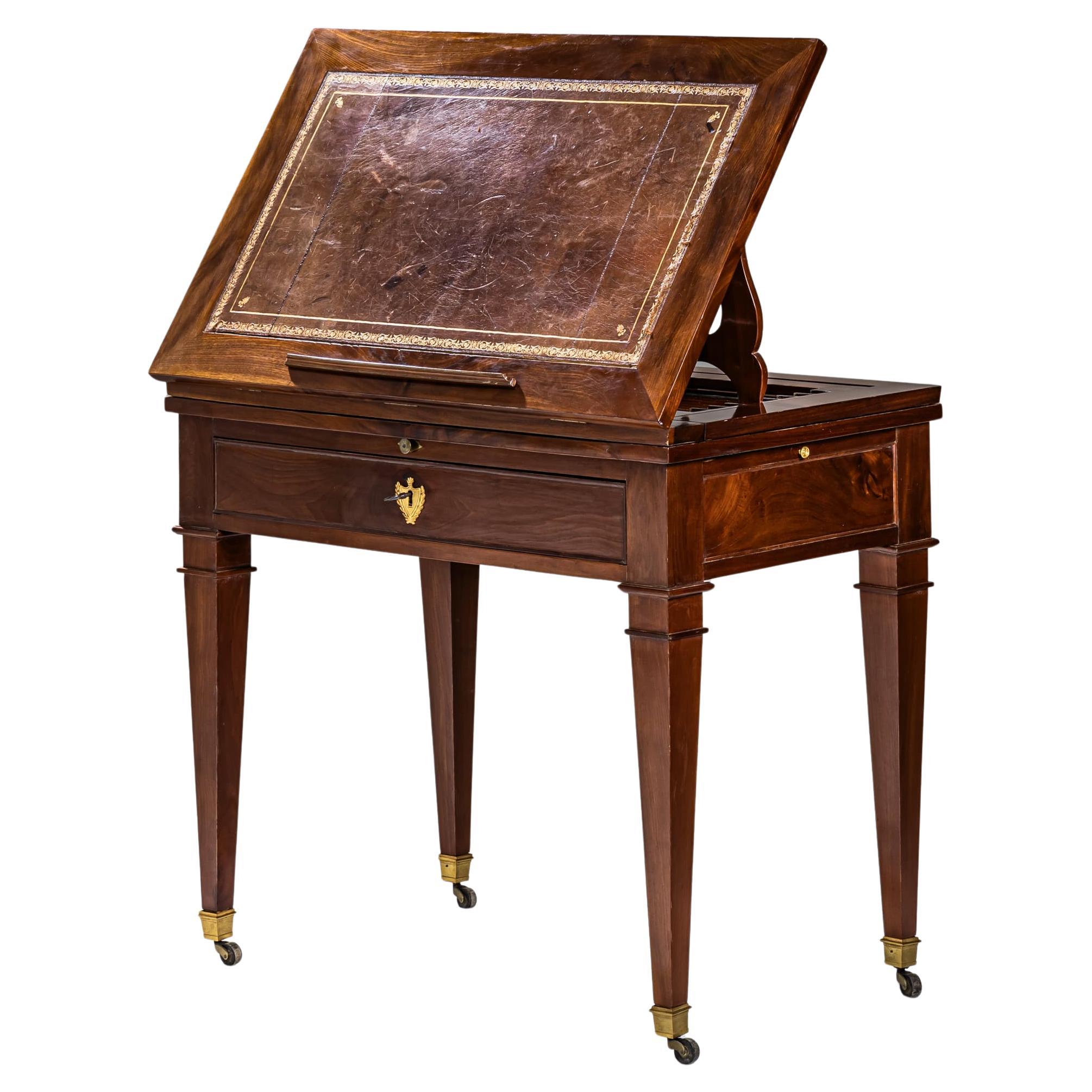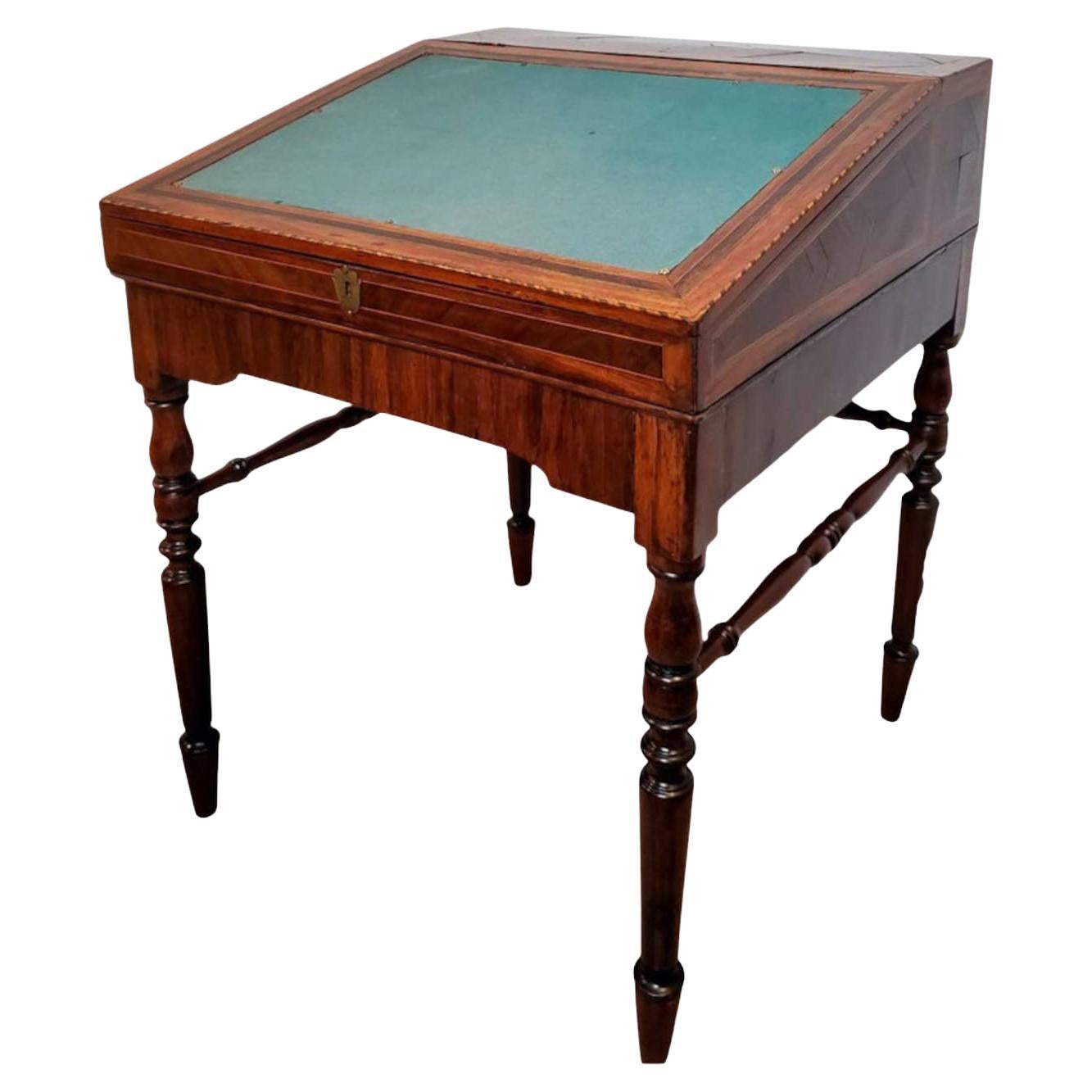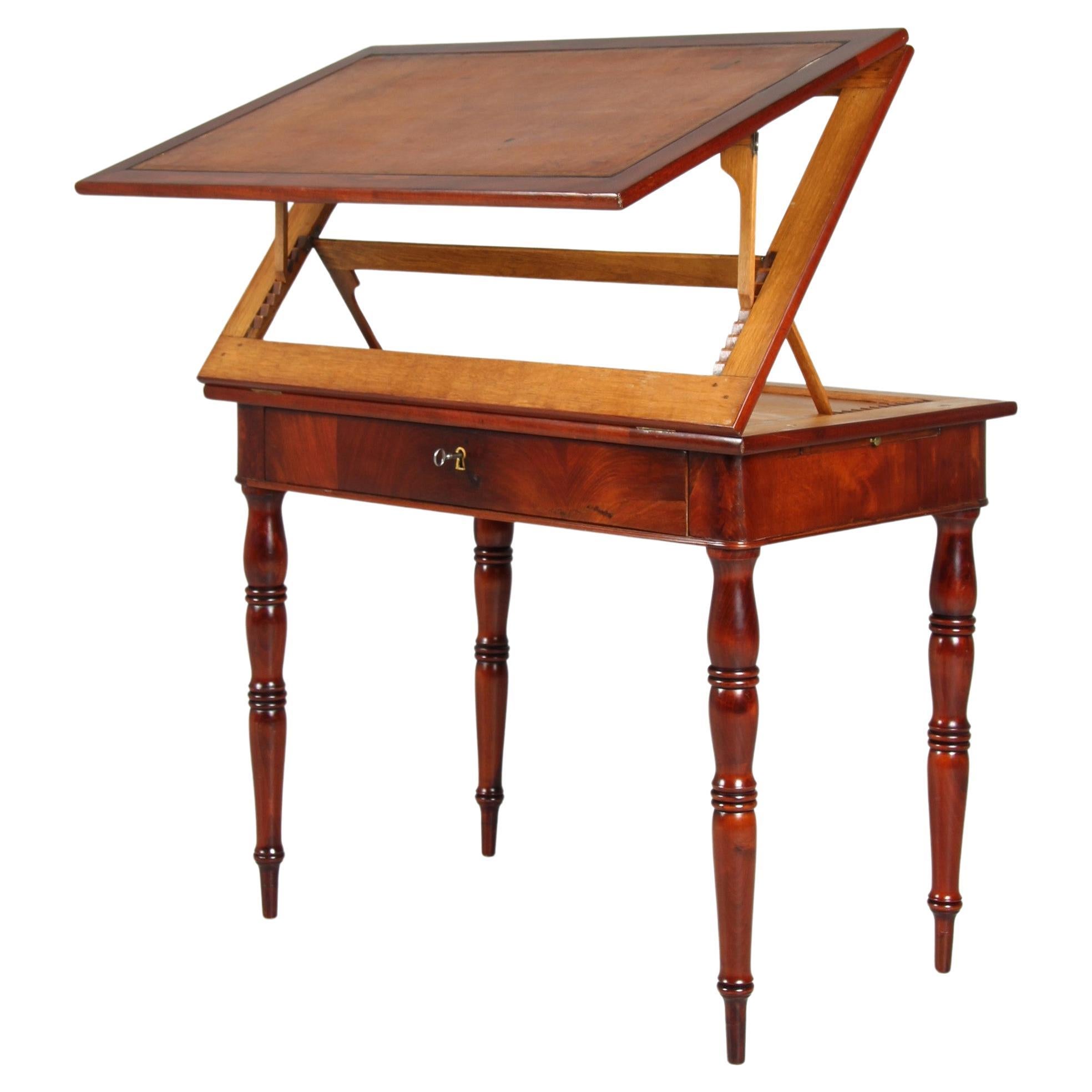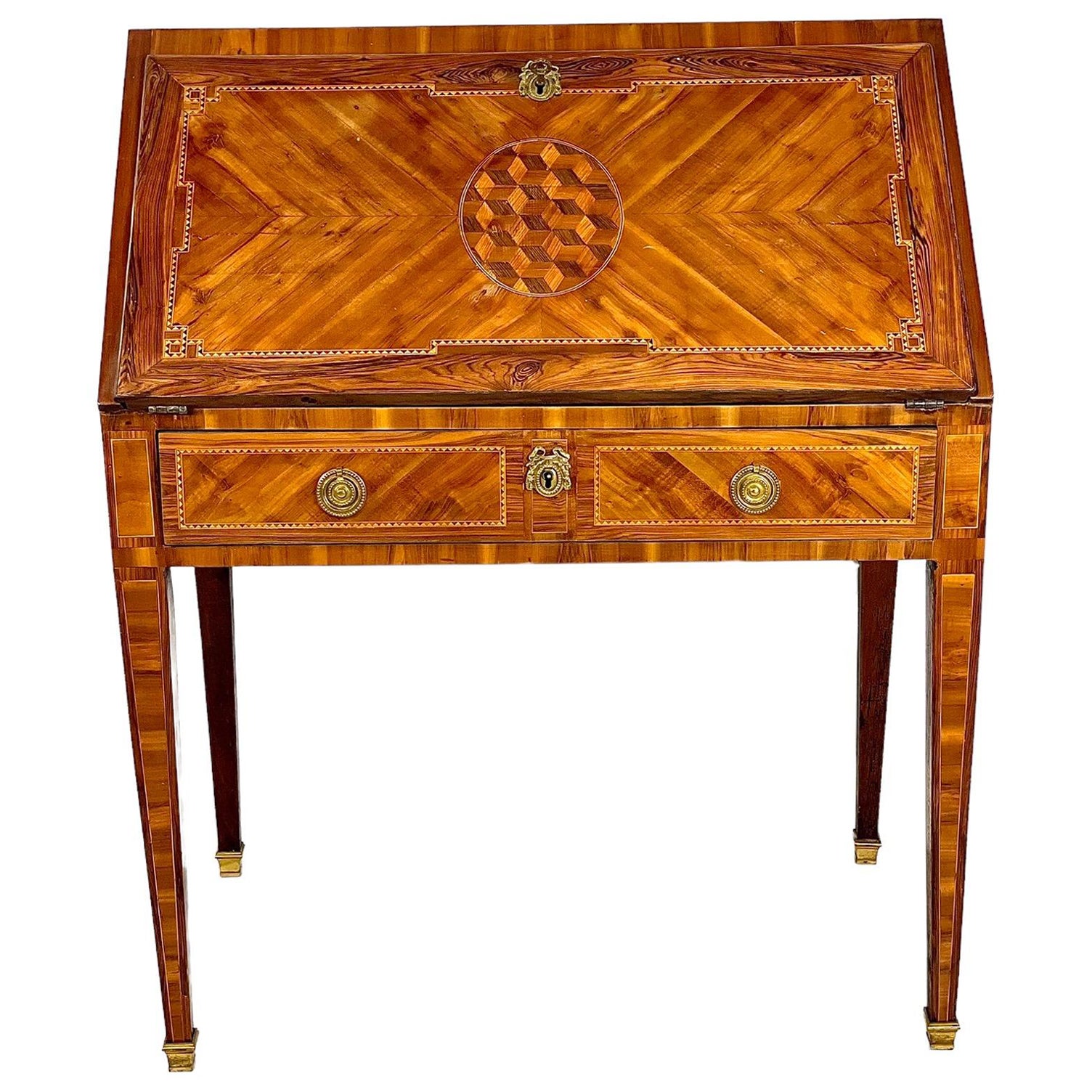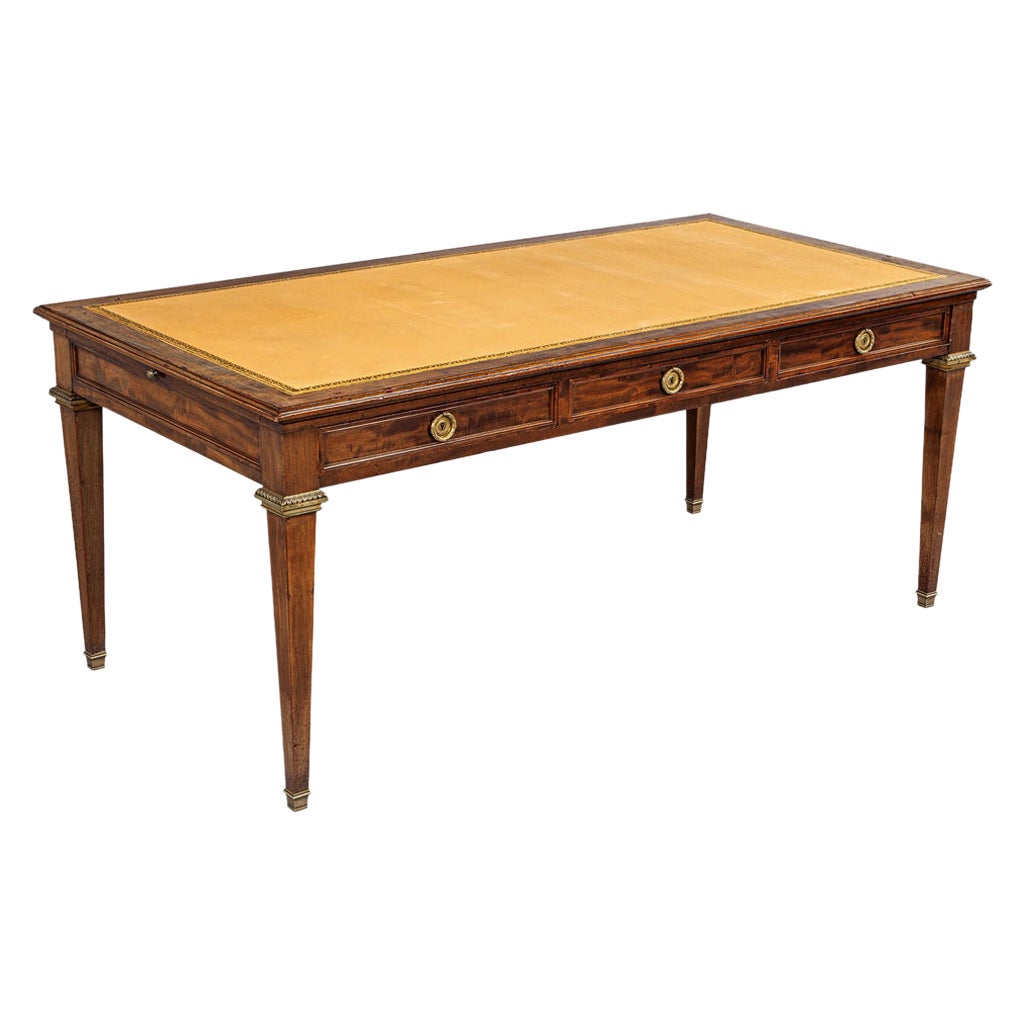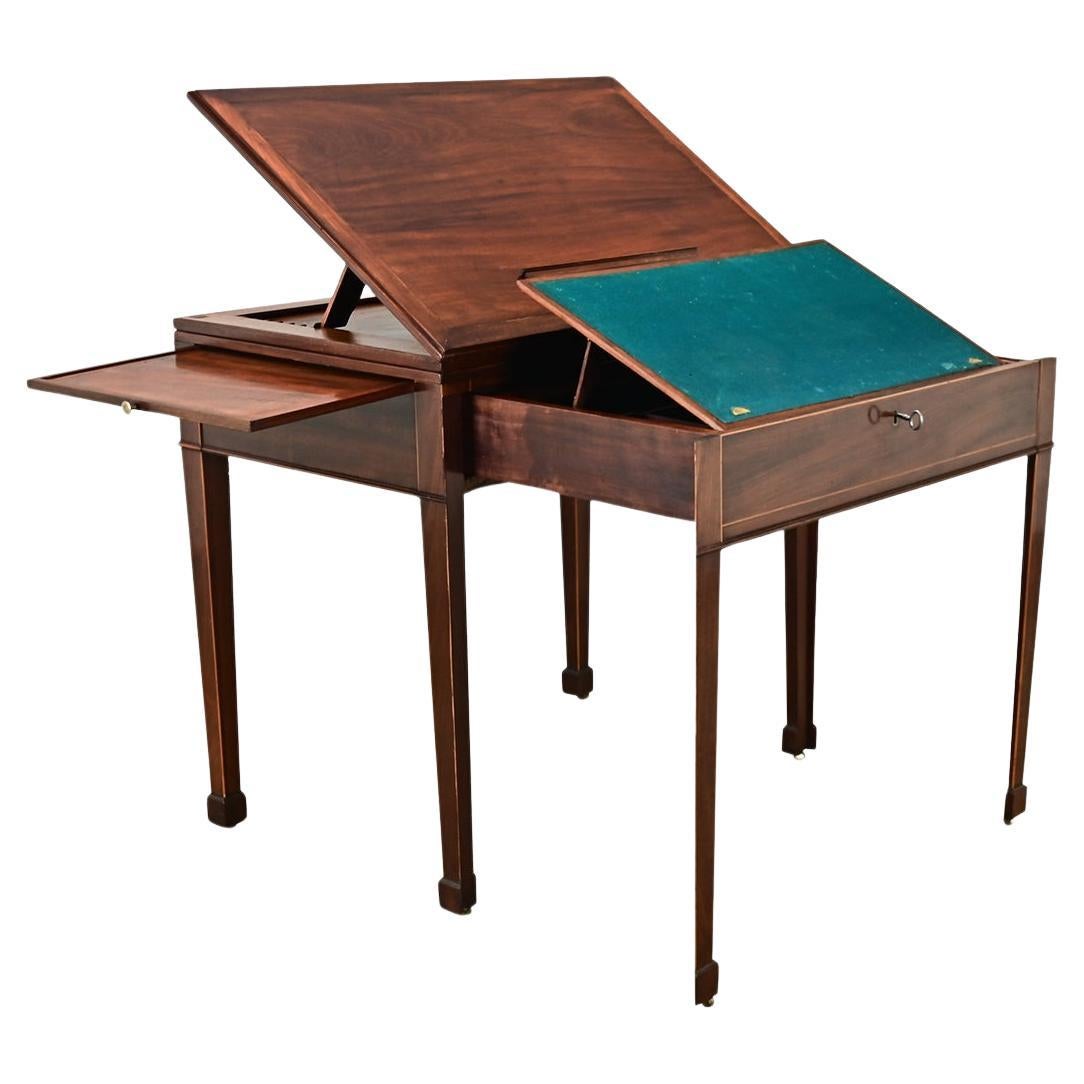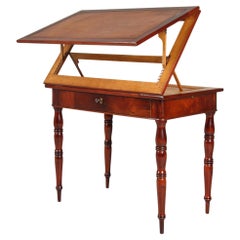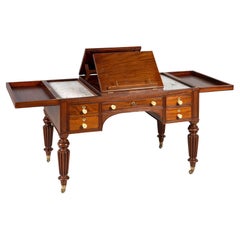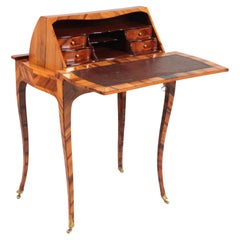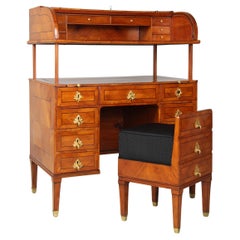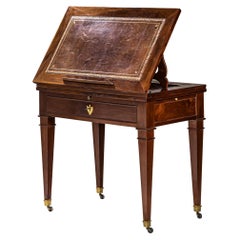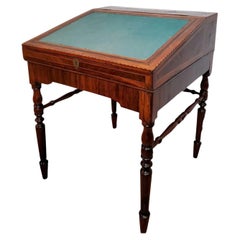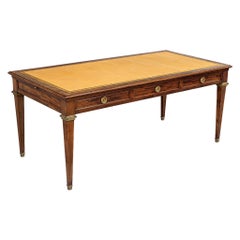Items Similar to High Adjustable Architect's Desk, Writing Desk, circa 1800
Video Loading
Want more images or videos?
Request additional images or videos from the seller
1 of 18
High Adjustable Architect's Desk, Writing Desk, circa 1800
$7,928.19
£5,980.30
€6,700
CA$11,124.64
A$12,131.22
CHF 6,372.85
MX$145,399.99
NOK 80,813.98
SEK 75,205.02
DKK 51,042.46
About the Item
Antique height-adjustable desk, architect's table, around 1800
France
Mahogany
circa 1800
Dimensions: H x W x D: 78 x 84 x 50
Height-adjustable to approx. 120 cm, can be folded up to a total height of approx. 155 cm.
Description:
Writing and work furniture standing on square legs tapering downwards and ending in brass sabots.
The relatively large cross-section of the legs makes it possible to accommodate the four supports which ensure that the upper part of the work surface can be raised. The desk-like top is then locked in ten different height positions with the help of four cotter pins inserted at the side. This makes the table suitable for both sitting and standing work.
The work surface can also be set up at different angles of inclination, while a removable bookend ensures that the piece of furniture can be used as a reading desk or for presenting drawings.
The drawer at the front has another writing surface that can be pushed backwards. Underneath is a compartment for storing drawing paper.
The side tableau pull-outs were probably primarily used to store drawing utensils, candlesticks or similar items.
There is a hinged drawer on the right-hand side for storing ink and grit.
The austere and classic design goes well with the overall technical impression of the piece of furniture.
Interesting facts:
In the 18th century, there was an enthusiasm for furniture that concealed mechanisms and gear racks and that showed innovation in the cabinetmaker's craft, such as the desk offered here, the "Table à la Tronchin".
The Parisian cabinetmaker Louis Dufour (master craftsman 1764), who ran his workshop in the Rue Saint-Hyacinthe until the beginning of the Revolution, is considered the inventor of this table. He specialised in mechanical furniture and produced, among other things, armchairs for hospitals, chairs that could be converted into a bed and folding library ladders.
However, the type of furniture was not named after its inventor, but after the Geneva-born physician Théodore Tronchin (1709-1781), who was researching bone diseases at the time, which were often the result of architects sitting badly at their desks. He recommended to his patients a table with a tilting and height-adjustable table top, depending on whether they wanted to work standing or sitting.
Condition:
Restored, stable and suitable for everyday use.
- Dimensions:Height: 30.71 in (78 cm)Width: 33.08 in (84 cm)Depth: 19.69 in (50 cm)
- Style:Louis XVI (Of the Period)
- Materials and Techniques:
- Place of Origin:
- Period:
- Date of Manufacture:1800
- Condition:Wear consistent with age and use. Very good condition. Restored, stable and suitable for everyday use.
- Seller Location:Greven, DE
- Reference Number:1stDibs: LU5419244809872
About the Seller
5.0
Platinum Seller
Premium sellers with a 4.7+ rating and 24-hour response times
Established in 2014
1stDibs seller since 2020
207 sales on 1stDibs
Typical response time: 1 hour
- ShippingRetrieving quote...Shipping from: Münster, Germany
- Return Policy
More From This Seller
View AllMid 19th Century High-Adjustable Architect's Table, Mahogany, France, circa 1850
Located in Greven, DE
High-Adjustable Architect's Table
France
Mahogany
Mid 19th century
Dimensions: H x W x D: 79 x 93 x 56 cm, height adjustment: 79 - 120 cm
Description:
Rare writing and drawing tab...
Category
Antique Mid-19th Century French Louis Philippe Desks and Writing Tables
Materials
Mahogany
Very Rare Convertible Desk, Partnerdesk, Dressing Table, Early 19th Century
Located in Greven, DE
Make-up table and desk as transformable furniture
England
Mahogany
early 19th century
Dimensions: H x W x D: 80 x 120 x 75 cm
Description:
Extremely rare and refined multifunction...
Category
Antique Early 19th Century British Early Victorian Desks and Writing Tables
Materials
Mahogany
Transforming Ladies Desk, so called Secretaire a Culbute, France, 19th Century
Located in Greven, DE
Convertible small desk - so-called Secrétaire à culbute
France
19th c.
Dimensions: H x W x D: 70 x 65 x 47 cm
Description:
Quite rare and unusual Louis XV style transforming furni...
Category
Antique 19th Century French Louis XV Desks and Writing Tables
Materials
Wood
18th Century High Adjustable Secretaire Desk with integrated Hidden Chair, 1780
Located in Greven, DE
Antique desk as transformable furniture with standing desk and integrated chair
Southern Germany
Cherry
around 1780
Dimensions: H x W x D: 115 x 107 x 69 cm
Description:
Exception...
Category
Antique 1780s German Louis XVI Secretaires
Materials
Cherry
19th Century Transforming Table, Ladies Desk, Secretaire, Walnut, France ca 1860
Located in Greven, DE
Small antique secretary, lady's desk
France
Walnut
around 1860
Dimensions: H x W x D: 90 x 59 x 53 cm
Description:
Quite extraordinary small piece of transforming furniture...
Category
Antique Mid-19th Century French Louis XV Secretaires
Materials
Walnut
Secretaire à la Bourgogne, Transformation Table, Louis XV Style, 19th Century
Located in Greven, DE
Very rare antique desk or secretary, so-called bureau à transformation "à la Bourgogne" in Louis XV style.
France
Walnut
19th century
Dimensions: H...
Category
Antique 19th Century French Louis XV Secretaires
Materials
Bronze
You May Also Like
Architect’s Desk à la Tronchin, France circa 1800
Located in Greding, DE
Rare architect’s desk in the à la Tronchin style, featuring an adjustable-height writing surface and two pull-out side trays—all lined in brown leather. A wide drawer beneath the top...
Category
Antique Early 1800s French Neoclassical Desks and Writing Tables
Materials
Brass
Antique Slant-Front Drafting Desk Writing Table
Located in Forney, TX
A rare and exceptionally inlaid antique slant-front drafting desk. circa 1900
Hand-crafted in the early 20th century, likely French, one piece desk on frame form, having a sloped fr...
Category
Early 20th Century Louis XVI Desks and Writing Tables
Materials
Ebony, Kingwood, Mahogany, Maple, Palisander, Rosewood, Burl, Felt
18th Century Louis XVI Period Fall Front Desk
Located in LA CIOTAT, FR
This elegant writing desk, known quirkily as a “bureau à dos d’âne” (donkey’s back desk), is beautifully veneered in rosewood, including reverse diamonds and butterfly-wings, which a...
Category
Antique 18th Century French Louis XVI Desks
Materials
Bronze
Antique Leather Top French Louis XVI Style Writing Desk
Located in North York, ON
This antique French Louis XVI style writing desk, crafted in France circa 1940s, exudes timeless elegance and classical refinement. Made from walnut with a light natural finish, it f...
Category
Vintage 1940s French Louis XVI Desks and Writing Tables
Materials
Brass
Dutch 18th Century Architect’s Desk
Located in Baton Rouge, LA
A versatile Dutch architect’s desk from the late 1700’s. This mahogany desk has an adjustable tilt top drafting surface with six distinct height options. The writing surface is 32 ¼”...
Category
Antique 18th Century Dutch Other Desks
Materials
Brass
Beautiful Louis XVI Style Writing Table, France, Circa 1880
Located in PARIS, FR
Beautiful Louis XVI style wooden writing table. The rectangular top, surrounded on three sides by a fine pierced and gilt-bronze frieze, above a d...
Category
Antique 1880s French Louis XVI Desks and Writing Tables
Materials
Bronze
More Ways To Browse
Foldable High Top Chairs And Table
Louis Xvi Tilt Top Table
Antique Folding Bed
Antique Folding Beds
Table A La Tronchin
Used Hospital Chairs
Scandinavian Boomerang Desk
Scandinavian Partners Desk
Shaker Desk
Sligh And Lowry Desk
Sligh Lowry Desk
Small Danish Modern Desk
Stickley Secretary Desk
Table Carved Man
Theodore Alexander Writing Table
Thonet Bruno Weil
Tl2 Albini
Triangle Desk
